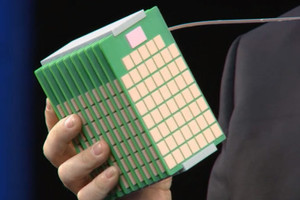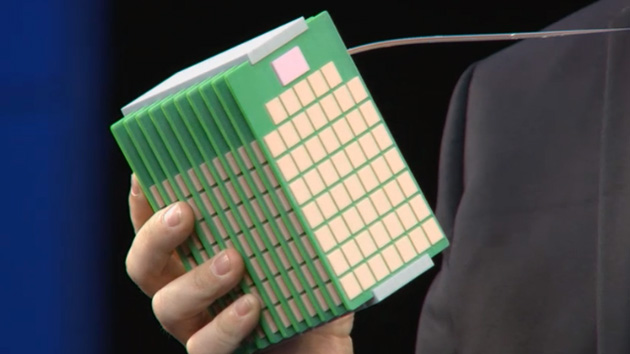
If Hewlett-Packard founders Bill Hewlett and Dave Packard are spinning in their graves, they may be due for a break. Their namesake company is cooking up some awfully ambitious industrial-strength computing technology that, if and when it’s released, could replace a data center’s worth of equipment with a single refrigerator-size machine. Hear about The Machine and what the future of technology looks like from Martin Fink, HP Chief Technology Officer, Director of HP Labs and General Manager of HP’s Network Function Virtualization (NFV) group.


The Machine Prototype
That’s what they’re calling it at HP Labs: “the Machine.” It’s basically a brand-new type of computer architecture that HP’s engineers say will serve as a replacement for today’s designs, with a new operating system, a different type of memory, and superfast data transfer. The company says it will bring the Machine to market within the next few years or fall on its face trying. “We think we have no choice,” says Martin Fink, the chief technology officer and head of HP Labs, who is expected to unveil HP’s plans at a conference.
Meg Whitman & Martin Fink discuss The Machine at HP Discover Barcelona 2014 General Session Day 2
HP 'The Machine'. - Summary Highlights
A decade ago, it wouldn’t seem as outlandish as it now does for a company such as HP, IBM, or Sun Microsystems to build a new computer architecture from the ground up. The hardware powerhouses, known as systems companies, all made their own chips, networking technology, and custom OS. Then commodity components became more powerful, and better data center software began to make up for deficiencies in the cheaper hardware. Consumer Web companies such as Google, Amazon.com (AMZN), and Yahoo! advanced new data center designs that were quickly adopted by the mainstream, shrinking the market share of the systems companies.
![]()
HP Labs, the company’s R&D arm, was once revered throughout Silicon Valley as a steady source of new products that could open up new markets. It’s been far less inspiring in recent years, ginning up a mishmash of mobile software, printing services, and teleconferencing systems that haven’t made it to customers in a meaningful way. Amid budget cuts, a costly, complex new computer system would seem like a stretch.
The Machine started to take shape two years ago, after Fink was named director of HP Labs. Assessing the company’s projects, he says, made it clear that HP was developing the needed components to create a better computing system. Among its research projects: a new form of memory known as memristors; and silicon photonics, the transfer of data inside a computer using light instead of copper wires. And its researchers have worked on operating systems including Windows, Linux, HP-UX, Tru64, and NonStop.
Photograph by Richard Lewington/Hewlett-PackardA memristor characterization experiment at HP Labs
Fink and his colleagues decided to pitch HP Chief Executive Officer Meg Whitman on the idea of assembling all this technology to form the Machine. During a two-hour presentation held a year and a half ago, they laid out how the computer might work, its benefits, and the expectation that about 75 percent of HP Labs personnel would be dedicated to this one project. “At the end, Meg turned to [Chief Financial Officer] Cathie Lesjak and said, ‘Find them more money,’” says John Sontag, the vice president of systems research at HP, who attended the meeting and is in charge of bringing the Machine to life. “People in Labs see this as a once-in-a-lifetime opportunity.”

Memory represents perhaps the biggest opportunity for change. Computers have worked in a similar way for many years now. When a person wants to do something such as run Microsoft Word, the computer’s central processor will issue a command to copy the program and a document from the slow disk it had been sitting on and bring it temporarily into the high-speed memory known as DRAM that sits near the computer’s core, helping ensure that Word and the file you’re working on will run fast.
A problem with this architecture, according to computing experts, is that DRAM and the Flash memory used in computers seem unable to keep pace with the increase in data use. As the current memory technology hits its physical limits, dozens of companies continue to work on possible replacements. “Everyone on the planet who is paying any attention to this type of thing wants to see this new kind of fast, cheap, persistent memory,” says Greg Papadopoulos, a partner at the venture capital firm New Enterprise Associates. “If one of these things works, and one of them will, it will change computing architecture fundamentally.”
